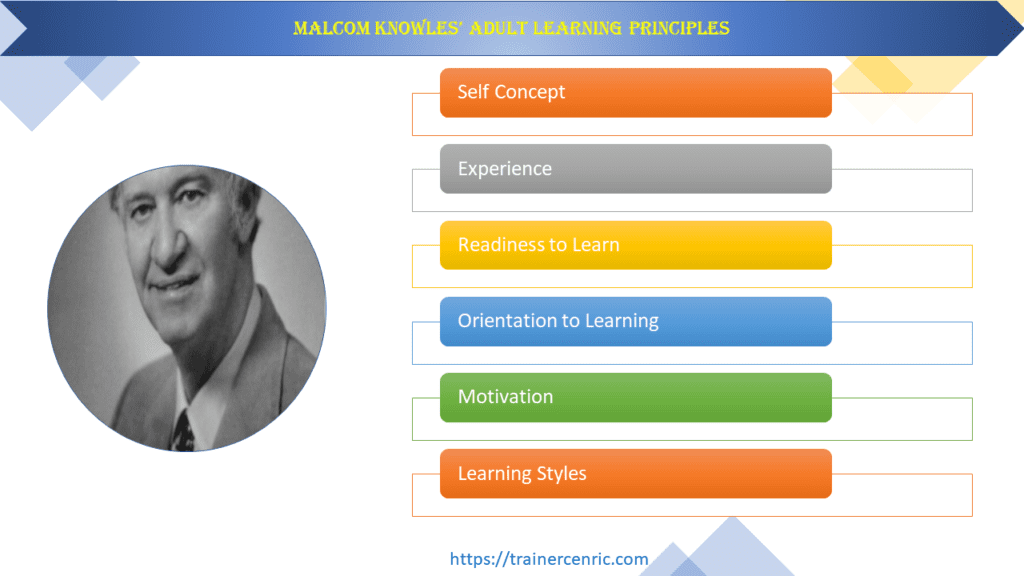Introduction to Malcolm Knowles’ Adult Learning Principles:
Malcolm Knowles was a renowned educator and advocate for adult learning. His work in the field of adult education emphasized the importance of understanding the unique characteristics of adult learners and tailoring instruction to meet their needs.

Understanding how adults learn is crucial for educators and instructional designers to create effective learning experiences. Malcolm Knowles, a highly respected educator and advocate for adult learning, introduced six principles that highlight the distinctive characteristics of adult learners. In this article, we will delve into these principles, exploring how they can be leveraged to design impactful instructional materials.
Knowles identified six principles of adult learning that are essential for effective instruction. These principles are based on the belief that adults learn differently from children and that adult learning is a distinct and unique process.
Self Concept : Empowering Adult Learners

The first principle, self-concept, recognizes the adult learner’s strong desire for autonomy and self-direction. Adults yearn to take charge of their education and comprehend the benefits of a specific learning experience. At the outset of any training session, it is vital to explicitly articulate the purpose of the learning, ensuring clarity for adult learners.
By involving adult learners in the planning and evaluation of their own educational journeys, we honor their need for autonomy. Furthermore, providing opportunities for learners to contribute feedback on the learning process fosters confidence and a sense of independence.
The principle of self-concept (Malcolm Knowles’ Adult Learning Principles) recognizes that adults have a profound need to be self-directed and autonomous in their learning. They want to be in charge of their own learning and understand how a specific learning experience will benefit them. This implies that adult learners must participate in the planning and evaluation of their own learning experiences. They also need chances to provide feedback on the learning process, which can help to boost their confidence and sense of autonomy.
Experience: Tapping into Prior Knowledge
The second rule of Malcolm Knowles‘ Adult Learning Principles is experience. Adult students contribute a wealth of experience to the learning process. They seek to relate their new information to their prior experiences and understanding. To enable students to reflect on their experiences and add to their prior information, instruction must be created in this manner.

The principle of experience recognizes that adult learners bring a wealth of experience to the learning process. They want to connect their new learning to their prior experiences and knowledge. This means that instruction should be designed to allow learners to reflect on their experiences and build upon their existing knowledge. Adult learners are also interested in learning things that are relevant to their lives and work experiences. Therefore, instruction should be designed to be practical and immediately applicable to their daily lives.
The principle of experience acknowledges the wealth of knowledge and experiences adult learners bring to the table. They seek connections between new information and their existing understanding. Therefore, instructional design should encourage reflection on personal experiences and facilitate the expansion of prior knowledge.
To harness the power of experience, learning materials should be designed to enable learners to relate their new learnings to their past encounters. Moreover, adult learners are keen to acquire practical skills applicable to their personal and professional lives. Therefore, instruction should emphasize real-life relevance, making the learning immediately useful and meaningful.
Readiness to Learn : Igniting Intrinsic Motivation
The third rule of Malcolm Knowles’ Adult Learning Principles is readiness to learn. When adults sense the need to know something, it motivates them to learn. They are more open to learning when they believe it will help them address a pressing issue or need in their daily lives. This innate drive should be utilized in instructional design.

The principle of readiness to learn (Malcolm Knowles’ Adult Learning Principles)emphasizes the importance of motivation in adult learning. Adult learners are motivated to learn when they feel a need to know something. They are most receptive to learning when they perceive that the learning will help them to solve a real-life problem or meet a specific need. Instruction should be designed to take advantage of this natural motivation by presenting material that is relevant and applicable to their current situation.
Adult learners exhibit heightened motivation when they perceive a genuine need to acquire knowledge. Their openness to learning is closely tied to the belief that it will address an urgent issue or fulfill a personal requirement. Leveraging this innate drive is key to instructional design.
The principle of readiness to learn underscores the importance of motivation in adult education. Instructional materials should align with learners’ immediate needs, presenting content that is directly relevant and applicable to their present circumstances. By capitalizing on this natural motivation, educators can cultivate an environment that encourages adult learners to dive deeper into the learning experience.
Orientation to Learning: Cultivating Goal-Orientedness
The fourth rule of Malcolm Knowles’ Adult Learning Principles is Orientation to learning. Adult learners are goal-oriented and want to know the relevance of what they are learning. They need to understand why they are learning something and how it will benefit them. Instruction should be designed to make these connections clear.

The principle of orientation to learning (Malcolm Knowles’ Adult Learning Principles)recognizes that adult learners are goal-oriented and want to know the relevance of what they are learning. They need to understand why they are learning something and how it will benefit them. Instruction should be designed to make these connections clear. For example, instructors can explain how the material being taught will help learners achieve their personal or professional goals.
The principle of orientation to learning highlights that adult learners are goal-oriented individuals seeking to understand the purpose behind their educational endeavors. They crave knowledge of why they are learning something and how it will benefit them. Instructional design should make these connections explicit and transparent.
To cater to the goal-oriented nature of adult learners, instruction should elucidate the practical implications of the learning material. Instructors can effectively communicate how the content being taught will help learners achieve their personal or professional aspirations. By establishing these connections, adult learners can maintain focus and engagement throughout their educational journey.
Motivation : Fostering Intrinsic Drive
The fifth rule of Malcolm Knowles’ Adult Learning Principles is Motivation. For Adult learners, motivation is essential. They must be driven to learn, and this motivation may come from both internal and external factors. By enabling students to relate their learning to their own interests and experiences, instruction should be created to encourage intrinsic motivation.

Adult learners must adhere to the motivation concept. They must be motivated to learn, which can stem from both internal and external variables. Adult learners require intrinsic drive, or motivation from within. Instruction should be intended to encourage intrinsic motivation by enabling students to connect their learning to their personal interests and experiences. Instructors, for example, can encourage students to share their own experiences and insights, which can boost students’ desire to learn.
Motivation plays a pivotal role in the learning process for adult learners. To ensure their engagement, adult learners must feel driven to acquire knowledge. This motivation can stem from both internal and external factors. Encouraging intrinsic motivation is especially crucial, as it stems from within the learner.
Instructional design should be geared towards fostering intrinsic motivation by enabling learners to connect their learning with their own interests and experiences. Instructors can facilitate this process by inviting learners to share their personal insights and experiences, thereby enhancing their desire to learn and explore the subject matter.
Learning Styles
The sixth and the last rule of Malcolm Knowles’ Adult Learning Principles is Learning styles. Adult learners have a range of learning preferences, so teaching should be created to take these variations into account. While some students may favor hands-on tasks, others may favor learning with visual aids. Different learning styles should be accommodated in the design of instruction by offering a diversity of learning opportunities.

The principle of learning style (Malcolm Knowles’ Adult Learning Principles) acknowledges that adult learners have a variety of learning styles, and instruction should be tailored to accommodate these differences. Some students may prefer to learn through visual aids, while others may prefer to learn through hands-on exercises. Instruction should be intended to provide a variety of learning experiences that accommodate various learning styles. This can help to increase engagement and motivation while also improving learning results.
The final principle, learning styles, recognizes the diversity of preferences among adult learners. It is essential to design instruction that accommodates these variations to ensure inclusivity and optimize learning outcomes. Some learners may thrive in a hands-on environment, while others may prefer visual aids.
Acknowledging the principle of learning styles, instructional materials should incorporate a variety of learning opportunities to cater to different preferences. By offering a range of learning experiences, such as visual aids, hands-on exercises, or interactive discussions, educators can enhance engagement, motivation, and overall learning effectiveness.
Conclusion
In conclusion, Malcolm Knowles’ Adult Learning Principles provide a framework for understanding how adults learn and how instruction can be designed to meet their unique needs. By understanding these principles, instructors can create effective and engaging learning experiences that are tailored to the needs and motivations of adult learners.
Overall, Malcolm Knowles’ Adult Learning Principles emphasize the importance of understanding the unique needs and characteristics of adult learners. By designing instruction that takes into account these principles, instructors can create engaging and effective learning experiences that help adult learners achieve their goals.
Malcolm Knowles’ Adult Learning Principles serve as a valuable framework for understanding how adults learn and how instructional design can be tailored to meet their unique needs. By embracing these principles, educators and instructional designers can create impactful and engaging learning experiences that align with the motivations, goals, and learning preferences of adult learners.
Ultimately, the principles of self-concept, experience, readiness to learn, orientation to learning, motivation, and learning styles shed light on the distinctive nature of adult learners. By integrating these principles into instructional design, educators can empower adult learners to achieve their educational objectives successfully.

![The Power of Storytelling in Corporate Training: Igniting Success and Inspiring Growth [2023]](https://trainercentric.com/wp-content/uploads/2023/06/storytelling-1024x576.jpg)

